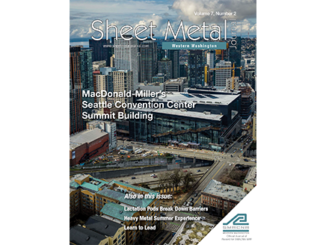
By Peter Boileau, Chairperson, SMACNA-Western Washington Code & Technical Committee
It’s been a busy summer in the development of new regulations in the State of Washington that affect our industry. We have seen an 11th hour delay in the implementation of new energy codes and an entirely new set of proposed regulations concerning the use of refrigerants in HVAC and refrigeration systems recently released. The SMACNA Western Washington Code and Technical Committee has been tracking these issues closely and has provided the following updates for our members.
Washington State Energy Code Updates: Implementation of the 2021 Washington State Energy Code was delayed from last June to this coming October 2023. This is to allow time for the State Building Code Council (SBCC) to convene two Technical Advisory Groups to consider stakeholder proposals to modify sections in the commercial and residential energy codes. The modification is intended to address legal uncertainty stemming from the California Restaurant Association v. City of Berkeley court decision recently issued by the federal Ninth Circuit Court of Appeals and has been similarly challenged in our state. This decision allows for continuation of the use of natural gas for commercial and residential buildings.
The 2021 version of the code ready for adoption this summer included requirements for use of electric heat pumps in lieu of gas heating for most building applications. With the federal ruling our state will need to allow gas use in both commercial and residential buildings (at least for this latest energy code cycle). The SBCC is now navigating a path to align with the federal court’s decision to retain natural gas as an energy source, but to also drive builders and developers towards the use of heat pumps for both HVAC and domestic hot water generation and discourage the use of natural gas.
One proposed “solution” to promote the use of heat pump technology instead of gas is to adjust the 2021 code language to make the selection of energy source part of the credit-based system used in the current code under Section C-406. This section describes energy efficiency requirements for permitting that sets the minimum number of “credits” required to be code compliant based on a list of energy efficiency measures. Each measure is described and includes its own efficiency “credits” score. There are measures and associated points for building envelope, mechanical, plumbing, and electrical systems, and a combination of these must be incorporated into the project to meet the total credits required to be code compliant and obtain a permit. These new credits are described in Tables in Section C406 and, depending on your project’s occupancy type, you will need to incorporate between 41 and 74 credits from the 31 categories included in this table. For existing building additions, you will need between 20 and 36 credits to meet permit requirements. Discussion currently underway may give additional credits for the use of heat pumps and include negative credits if gas is used as an energy source. This would result in needing offsetting additional credits (e.g., better glazing systems, more insulation, or higher efficiency lighting and HVAC systems) to offset the use of gas in a building.
The current schedule for recommendations to be made to address which energy source will be used will be at a meeting of the State Building Code Council and its technical advisory groups on September 15. It will be interesting to see how this new wrinkle in our progressive energy code will be solved this fall for implementation of the new 2021 energy code by the target date of October 29, 2023.
New Refrigerant Regulations: Just published are new proposed guidelines for refrigerants coming from the Washington State Department of Ecology dated August 2023. In 2021, the Washington Legislature passed HB 1050, the Hydrocarbons-Emissions Reduction Act. This law requires the Department of Ecology to establish maximum Global Warming Potential (GWP) for both existing and new refrigeration and air conditioning equipment. In general, HVAC systems using refrigerants with a GWP index of 750 or greater will be phased out between January of 2024 and January of 2028 depending on application. Some examples of refrigerants to be phased out include the widely used HFC-134A, and many of the HFC 200-series and R-400 series refrigerants, as well as R-507.
Under the proposed guidelines equipment owners currently using high GWP refrigerants will not be required to replace their existing equipment if the equipment remains in good operating condition and detected leaks of high GWP refrigerant are repaired. These owners will need to register with the Department of Ecology and participate in annual reporting as proposed in these new guidelines and as summarized below.
The new proposed guidelines establish a refrigerant management program for building owners with equipment containing over 50 pounds of refrigerant per facility. This program will require owners to follow record keeping and reporting requirements, which include continuous leak monitoring, regular inspections, and additional requirements for equipment service and repair reporting. This program also establishes the maximum allowable leakage threshold on all existing equipment currently in use.
In addition to new owner requirements, there will also be new refrigeration management program requirements for companies that install, repair, maintain, service, or dispose of refrigeration or air conditioning equipment, which will apply to all Washington based mechanical contractors.
Finally, these newly proposed guidelines require refrigerant suppliers and recyclers to follow new record-keeping and reporting requirements. Please keep in mind that at this time these are recommendations only. The Department of Ecology has, however, targeted approval of these new guidelines by the end of this year, so as SMACNA partners we need to follow this issue closely as it will likely and significantly impact our business practices.
As our industry moves forward incorporating more complexity in order to meet future regulations, perhaps we should take a step back and consider alternate paths to provide low energy human comfort solutions. Past generations from around the civilized world have relied on passive air-based cooling systems for human comfort and refrigeration. Persia’s ancient “cooling towers”, China’s “sky wells”, and the latticed “jaali” or “net” systems incorporated into monumental buildings in India, such as the Taj Mahal, have been used to direct cool outside air during night and early morning hours through buildings to evacuate heat collected during the day to make building interiors comfortable and prevent food spoilage. Why can’t we use modern sheet metal systems with either passive venturi effect systems or super-low fan energy boosting systems to both cool and flush out our modern buildings? These systems can both improve indoor comfort and air quality without the use of complex, high first-cost systems currently prescribed by our codes.
Our code and technical committee welcome your ideas on this subject as we develop our own solutions using our sheet metal-based knowledge and experience. ▪



